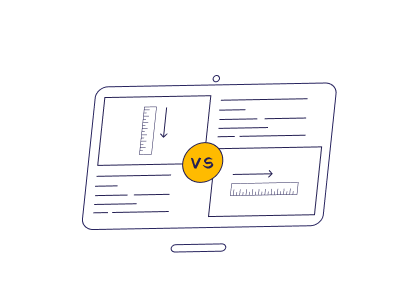When there are a lot of users using your application and when your application is on demand, with the growing demand, it is also important to expand the accessibility, power and reach of your application. So, what is the ideal option for your business? You can assess your application’s scale requirement and infrastructure constraints to decide between vertical vs horizontal scaling.
What you essentially want to do is add more computing resources to your existing infrastructure to be able to cope with the demand. When you scale up (vertical scaling), you are incorporating more power to your existing system. Whereas, when you scale out (horizontal scaling), you are adding more resources by adding more systems to your network, thereby distributing the processing and sharing workload throughout multiple devices.
Why Horizontal Scaling Is Better Than Vertical Scaling?
One way to approach this is to think about what is at stake when you scale up in comparison to when you scale out.
When evaluating horizontal scaling vs vertical scaling, horizontal scaling stands out as a superior solution, owing to its better resource utilization and smoother implementation. It improves system resilience by distributing workloads through parallel infrastructure. Horizontal scaling lets you work with your existing pool of computing resources and adds more resources to your infrastructure. The best benefit is that when you scale your app horizontally, you get more elasticity.
Do you want to understand what is vertical and horizontal scaling in cloud? Vertical scaling means upgrading existing servers, whereas horizontal scaling means adding more servers to share the load.
The benefits of horizontal scaling in a cloud environment include the following:
- Continuous availability
- Intuitive resource distribution
- pay-Per-Use concept
- Redundancy and elasticity
- Easy to size and resize as per your requirements
Here’s how horizontal scaling works for your app:
The most important benefit of scaling horizontally is that it provides the users the ability to increase the capacity/resources on the fly, therefore the functioning of your app is not affected. MilesWeb’s cloud environment is intuitive and user-friendly, it facilitates the automatic changing of the application server nodes according to the resources used by your application. You can determine the minimum and maximum number of nodes allowed and you can also determine the conditions for adding and removing these nodes through the triggers.
Horizontal scaling increases the capacity of your application by adding many software and hardware entities in such a way so that they function as a single unit. With horizontal scaling, the resilience of your infrastructure is improvised because of the presence of multiple discrete systems.
If you’ve implemented application roll-out before, you probably know how vertical and horizontal scaling in cloud can greatly influence app accessibility, responsiveness, and cost-effective development. The virtualization technology has simplified the process of scaling an application. Now, with the advent of cloud, it is possible to scale to infinity. You might have worked with some auto-scaling parameters based on the underlying system requirements like CPU, thread count etc. The question is – Can you scale your cloud environment to meet the demand? And the answer to this is adding of sufficient computing resources. Horizontal provides the perfect environment to take care of the growth of your app. If your app has high traffic ratio and if it is in demand, scale it horizontally to get more processing power and to achieve the faster functioning of your app.
FAQs
What is vertical and horizontal scaling in cloud?
Vertical scaling in the cloud is known as boosting existing server capacity, while horizontal scaling is used to scale servers to manage rising traffic and workload.
Which is better: vertical vs horizontal scaling?
In the context of vertical scaling vs horizontal scaling, horizontal scaling offers greater adaptability, robustness, and value for money, notably in cloud infrastructures.
How does horizontal scaling vs vertical scaling affect performance?
Horizontal scaling vs vertical scaling adopts different strategies. Horizontal scaling increases the machine count for parallel processing. In vertical scaling, the capacity of a single server increases, but it may reach its maximum capacity more quickly.
What are the benefits of vertical and horizontal scaling in cloud platforms?
Vertical and horizontal scaling in cloud offers various advantages. Vertical scaling implements quick upgrades with a simpler approach. Horizontal scaling improves resilience and ensures reliability.








